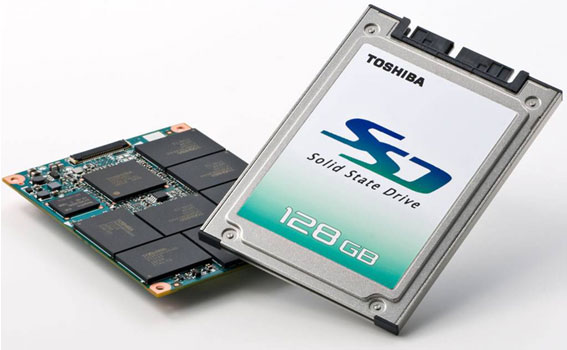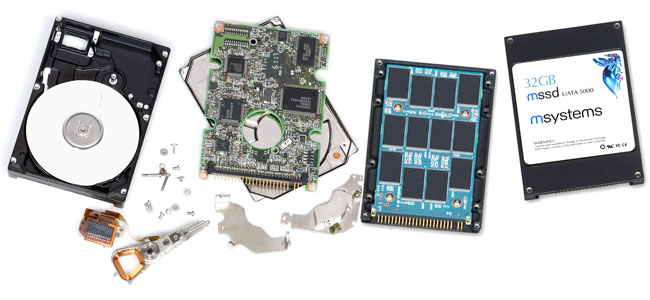
Give thanks for the good old hard drive. If there’s been one constant in the modern era of desktop computing – CPUs and motherboards notwithstanding – this is it. Initially unveiled in mainframe computers way back in the 1950s, first appearing in home systems in the early 1970s, and finally replacing removable floppy discs completely as the preferred method of high-volume storage in the mid-1980s, hard drives are a high-tech staple.
But that doesn’t mean they’re perfect. Ask anyone who’s experienced a hard drive failure, crash, or general implosion, and you’ll get far more curses than raves. Similarly, speak with someone who’s accidentally bumped their hard drive and lost data because of it, and you’ll get an icy stare rather than a satisfied smile. Let’s be honest too – we highly doubt that there’s anybody who really enjoys the whirr and clatter of a traditional hard drive as it goes about its daily routine to boot.
But crack open a hard drive and you might come away wondering how the little gizmos hold together as well as they do. In fact, you’d be forgiven for thinking the innards look like an old school phonographic turntable. There’s a lot of stuff in there, but the most immediately obvious features are the circular “platters” (upon which data is contained), the “spindle” (around which the platters spin – like a record), and the “actuator arm” (which reads and writes data to the platters and looks for all the world like a turntable tone arm).

Watching an uncovered hard drive in action is both impressive and frightening. The platters in most modern models spin at 7200 revolutions per minute, which by anyone’s standards is crazy fast. But hard drive platter rotations are nothing when compared to the frenetic movements of an actuator arm. It zips back and forth across the platters at speeds that are a mere blur to the human eye. Ultimately, one leaves a hard drive demonstration with a newfound respect for this oft-maligned device.
However, wouldn’t it be great if there were another storage technology that didn’t walk the edge of the durability and performance envelopes each time it operated? Wouldn’t it be great if that technology had no moving parts, made no noise, and could take the occasional hard knock without inching ever closer to an inevitable breakdown? Well, guess what: That technology is already here today. Indeed, it’s been here for a few years already. It’s called “solid state” (yep, a revival of the same term used decades ago to describe tech devices that had evolved from vacuum tubes to transistors), and it finally looks set to make serious inroads into the hard drive market.
Click here for our list of SSD hard drives so you can pick the one that’s right for you.
So how does the technology work – and, more importantly, why should it be of interest to any PC owner? Simple: Solid state drives (SSDs) rely upon motionless semiconductors instead of the magnetic media and actuator arms of traditional drives to read, write, and store data, and therefore have no moving parts and are theoretically much more reliable. Solid state drives can be much smaller than hard drives too – see USB thumb drives, for example – or they can be dressed up in alternate housing so they fit into the existing drive slots of laptops and PCs. They have no internal motor as well, so they use less power and make virtually no noise. And the best news of all: With no platters to “spin up” and mechanically access, solid state drives are also quite capable of delivering incrementally faster performance.

Bearing this in mind, what’s not to like? Well, for starters, SSD technology is still relatively new and somewhat unproven, and it’s certainly experienced its share of growing pains. Claims of long-term performance degradation and a variety of operational and speed issues in early models abound in various corners of the Internet, not just from everyday users, but from hardcore tech sites as well. Moreover, though SSDs have always read data at a very fast clip, many won’t write as fast as some traditional hard drives.
But something else has also derailed widespread adoption, and that something is price. The first generation of SSDs was impossibly expensive. Fortunately, the performance issues of early models – many of which were attributed to inferior controllers – have all but vanished in the most recent generation. Moreover, prices have taken a veritable nosedive this year as an increasing number of manufacturers have gotten into the act. Still, the cost per megabyte remains high in comparison to hard drives, which, feeling the heat of SSDs, are now more spacious and less expensive than they’re ever been.
So what’s a computer owner to do? The most logical approach may be to sit on the sidelines until price parity, which, according to several industry insiders, should occur by 2011. But that’s a long time to wait for the speed, the power efficiency, and the reliability of SSD.
In the meantime, a currently popular desktop arrangement is a two-pronged affair that blends the best of both worlds. An SSD is installed as the primary “boot” drive, where the operating system and applications are housed and speed and performance is crucial. One obvious benefit – you can wave bye-bye to protracted startup times. Meanwhile, user-created files, music, videos, and the like are stored on a comparatively spacious yet clunkier traditional hard drive.

SSDs are arguably a better fit, at least right now while prices are still relatively high, in the world of laptops. Here, where mega-size storage isn’t quite so important, and where the wear and tear and bumps and bruises of mobile life can occasionally impact or even destroy old-school drives (and make no mistake – SSDs are the way of the future), an SSD represents a highly viable alternative.
Ultimately, with the technology’s teething pains seemingly in the rear view mirror, today’s SSDs are a good bet for anyone who needs faster, quieter, smaller, more power efficient, and much more durable storage – and is willing to pay for it. Yet not all SSDs are created equal, and several are decidedly more desirable. Looking to make the upgrade? Check out our slideshow of the top 10 solid state drives for recommendations on the best SSD hard drive options for home and business use.
Click here for our list of SSD hard drives so you can pick the one that’s right for you.